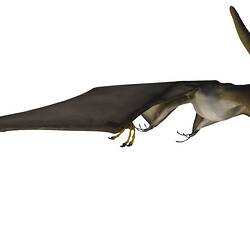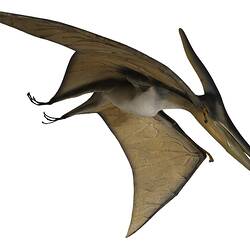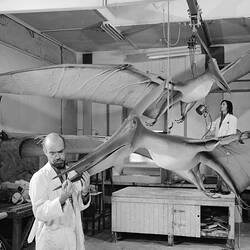Summary
The Museum's two Pteranodon models were constructed in-house by the Museum's Preparators in the late 1970s. Initially, detailed full-scale anatomical drawings were made from photos of fossils. Reference models were then made in polystyrene foam and clay and used to make fibreglass casts. These were sprayed with hemp flocking to give them a fuzzy texture before painting. The whole process took upwards of six months. On completion they were installed in McCoy Hall before moving to the new Melbourne Museum site where they hung in the original dinosaur exhibition.
Pteranodon are not dinosaurs as often thought but belong to a group of prehistoric flying reptiles called Pterosaurs. These were the earliest flying vertebrates in the fossil record with wings formed of a thin membrane stretching between their long finger bones and ankles. Pteranodon were among the largest of the Pterosaurs with wingspans of up to 7 meters. They lived during the late Cretaceous period, around 85 million years ago, over what is now North America. Over a thousand Pteranodon specimens have been found in marine deposits suggesting that they may have migrated across seas much like modern albatross do, by soaring for long periods with the help of updrafts.
Specimen Details
-
Taxon Name
-
Number Of Specimens
1
-
Sex
Unknown
-
Specimen Nature
Nature: Model, fibreglass
-
Category
-
Scientific Group
-
Discipline
-
Collecting Areas
-
Type of Item
Taxonomy
-
Kingdom
-
Phylum
-
Subphylum
-
Class
-
Order
-
Family
-
Genus
![<em>Tsintaosaurus spinorhinus</em>, hadrosaur dinosaur skeleton, cast (front) and <em>Pteranodon</em> pterosaur skeleton, cast (rear). [P 206976 & P 207267]](/content/media/23/274673-small.jpg)
![<em>Tsintaosaurus spinorhinus</em>, hadrosaur dinosaur skeleton, cast (front) and <em>Pteranodon</em> pterosaur skeleton, cast (rear). [P 206976 & P 207267]](/content/media/23/274673-thumbnail.jpg)


